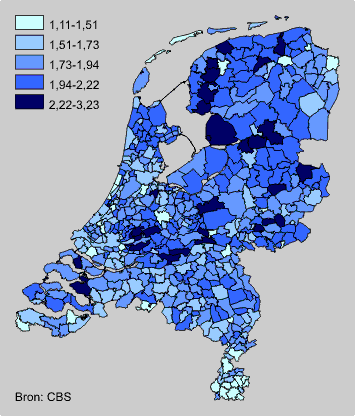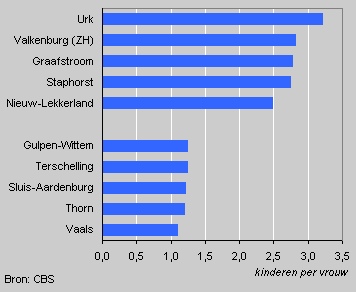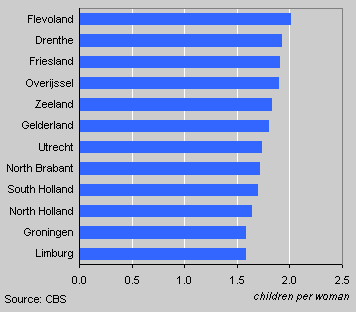Largest families in Urk

In 2002 the fertility rate in the Netherlands was 1.73 children per woman. In 1980 this was 1.6. There is a large regional variation in fertility. The difference between Urk, the most fertile municipality and Vaals, the least fertile, is 2.1 children per woman.
Fertility rate per municipality, 2002

High fertility in strict Protestant areas
The most fertile women by far live in Urk: 3.2 children per woman. Valkenburg (South Holland) comes second with 2.8 children per woman. Urk is part of the so-called Bible Belt. The other municipalities in this area are also high in the fertility rankings; Staphorst, for example, with 2.8 children per woman.
Five highest and five lowest municipal fertility rates, 2002

Fertility low in Limburg
The least fertile women live in the province of Limburg: in Vaals (1.1 child), and Thorn (1.2 child). Other municipalities in Limburg are also low on the list. Gulpen-Wittem and Maastricht are fifth and sixth from the bottom.
The inhabitants of Limburg are traditionally mainly Catholic. In the beginning of the twentieth century Catholic regions were characterised by relatively large families. Today it is the other way around. Interestingly, this pattern of very low fertility can also be seen elsewhere in Europe, and especially in countries with a predominantly Catholic population (Italy, Spain and Portugal).
Fertility per province, 2002

Flevoland most fertile province
The differences in fertility rates between provinces are significantly smaller than those between municipalities. The most fertile women live in Flevoland: 2.0 children per woman. Women in the provinces of Drenthe, Friesland and Overijssel also have significantly more children than the national average.
Remarkably, Groningen is the odd one out in this respect: it has the lowest fertility rate after Limburg. Women in Limburg have the least children: 1.6 each on average.
Andries de Jong